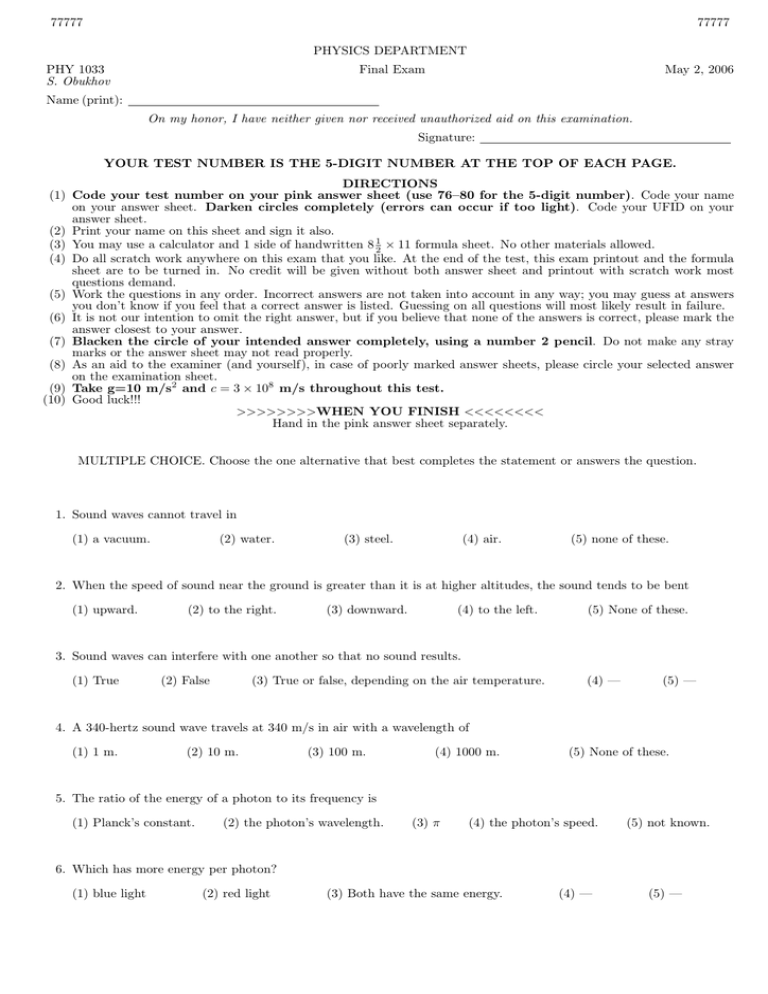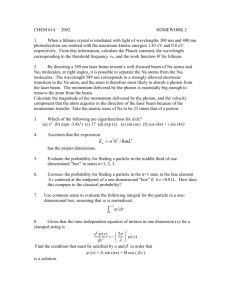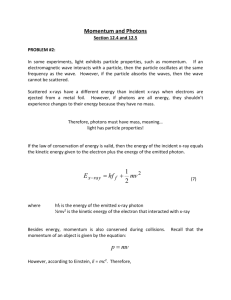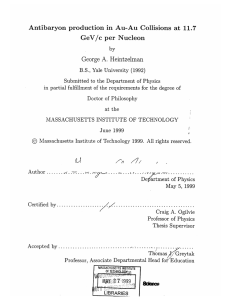77777 PHYSICS DEPARTMENT PHY 1033 Final Exam
advertisement

77777 77777 PHYSICS DEPARTMENT PHY 1033 S. Obukhov Final Exam May 2, 2006 Name (print): On my honor, I have neither given nor received unauthorized aid on this examination. Signature: YOUR TEST NUMBER IS THE 5-DIGIT NUMBER AT THE TOP OF EACH PAGE. DIRECTIONS (1) Code your test number on your pink answer sheet (use 76–80 for the 5-digit number). Code your name on your answer sheet. Darken circles completely (errors can occur if too light). Code your UFID on your answer sheet. (2) Print your name on this sheet and sign it also. (3) You may use a calculator and 1 side of handwritten 8 12 × 11 formula sheet. No other materials allowed. (4) Do all scratch work anywhere on this exam that you like. At the end of the test, this exam printout and the formula sheet are to be turned in. No credit will be given without both answer sheet and printout with scratch work most questions demand. (5) Work the questions in any order. Incorrect answers are not taken into account in any way; you may guess at answers you don’t know if you feel that a correct answer is listed. Guessing on all questions will most likely result in failure. (6) It is not our intention to omit the right answer, but if you believe that none of the answers is correct, please mark the answer closest to your answer. (7) Blacken the circle of your intended answer completely, using a number 2 pencil. Do not make any stray marks or the answer sheet may not read properly. (8) As an aid to the examiner (and yourself), in case of poorly marked answer sheets, please circle your selected answer on the examination sheet. (9) Take g=10 m/s2 and c = 3 × 108 m/s throughout this test. (10) Good luck!!! >>>>>>>>WHEN YOU FINISH <<<<<<<< Hand in the pink answer sheet separately. MULTIPLE CHOICE. Choose the one alternative that best completes the statement or answers the question. 1. Sound waves cannot travel in (1) a vacuum. (2) water. (3) steel. (4) air. (5) none of these. 2. When the speed of sound near the ground is greater than it is at higher altitudes, the sound tends to be bent (1) upward. (2) to the right. (3) downward. (4) to the left. (5) None of these. 3. Sound waves can interfere with one another so that no sound results. (1) True (2) False (3) True or false, depending on the air temperature. (4) — (5) — 4. A 340-hertz sound wave travels at 340 m/s in air with a wavelength of (1) 1 m. (2) 10 m. (3) 100 m. (4) 1000 m. (5) None of these. 5. The ratio of the energy of a photon to its frequency is (1) Planck’s constant. (2) the photon’s wavelength. (3) π (4) the photon’s speed. (5) not known. 6. Which has more energy per photon? (1) blue light (2) red light (3) Both have the same energy. (4) — (5) — 77777 77777 7. The photoelectric effect best demonstrates the (1) particle nature of light. (2) wave nature of light. (3) both of these (4) none of these (5) — 8. The uncertainty principle applies not only to momentum and position, but also to energy and time. This statement is (1) true. (2) false. (3) — (4) — (5) — 9. According to the uncertainty principle, the more we know about a particle’s momentum, the less we know about its (1) location. (2) speed. (3) mass (4) kinetic energy. (5) none of these 10. Two beams of light, a red beam and a blue beam, have the same energy. The beam with the greater number of photons is the (1) red beam. (2) blue beam. (3) both the same (4) — (5) — 11. X-rays may be regarded as (1) high frequency radio waves. (2) high frequency sound waves. (3) both of these (4) none of these (5) — 12. Which radiation has no electric charge associated with it? (1) gamma rays (2) alpha rays (3) beta rays (4) all of these (5) none of these 13. When a nucleus emits a beta particle, its atomic number (1) (2) (3) (4) (5) changes, but its mass number remains constant. changes, and so does its mass number. remains constant, and so does its mass number. remains constant, but its mass number changes. none of these 14. The atomic number of an element is the same as the number of its (1) protons. (2) nucleons. (3) neutrons. (4) partons. (5) — 15. The half-life on an isotope is one day. At the end of three days, how much of the isotope remains? (1) one-eighth (2) one-half (3) one-quarter (4) none (5) — 16. The helium in a child’s balloon is composed of A. former beta particles. B. alpha-particle remnants of previous radioactive processes. (1) both A and B (2) A only (3) B only (4) neither A nor B (5) — 17. Compared to clocks in a stationary reference frame, clocks in a moving reference frame run (1) slower. (2) faster. (3) at the same speed. (4) backwards. (5) — 77777 77777 18. Relativity equations for time, length and momentum hold true for A. everyday low speeds B. relativistic speeds (1) both A and B (2) A only (3) B only (4) neither A nor B (5) — 19. According to the special theory of relativity, if you measure your own pulse while traveling at very high speeds, you would notice your pulse rate to (1) be the same as usual. (2) decrease. (3) increase. (4) — (5) — 20. The length of a meterstick projected like a spear at 0.87c is seen by a person at rest to be (1) 0.5 m. (2) 1.5 m. (3) 1 m. (4) 1.25 m. (5) 0.87 m. 21. Suppose at the surface of the Earth a person can do 20 pushups. In a spaceship far away from any gravitational influence, accelerating at g, the same person could do (1) 20 pushups. (2) more than 20 pushups. (3) less than 20 pushups. (4) — (5) — 22. From a general relativistic point of view, a person on the ground floor of a skyscraper ages (1) (2) (3) (4) (5) slower than a person on the top floor. faster than a person on the top floor. at the same speed as a person on the top floor. this question cannot be answered. — 23. Fire a cannonball from a cannon and it curves due to gravity. Shine a light from a flashlight and it (1) (2) (3) (4) (5) curves per second the same as the cannonball. follows a straight-line path with no curvature at all. curves slightly, but not as much per second as the cannonball. curves half as much as the cannonball. not enough data. 24. Particle A has twice the charge of nearby particle B. Compared to the force on Particle A, the force on Particle B is (1) the same. (2) four times as much. (3) half as much. (4) twice as much. (5) None of these. 25. When two lamps are connected in parallel to a battery, the electrical resistance that the battery senses is (1) (2) (3) (4) (5) less than the resistance of either lamp. more than the resistance of either lamp. none of these impossible to say — 26. BONUS If the speed of a moving object doubles, which of the following also doubles? (1) momentum (2) acceleration (3) kinetic energy (4) inertia (5) — 77777 77777 27. BONUS Objects infinitely far away are focused by a converging lens (1) at the focal point. (2) beyond the focal point. (3) in front of the focal point. (4) — (5) —







